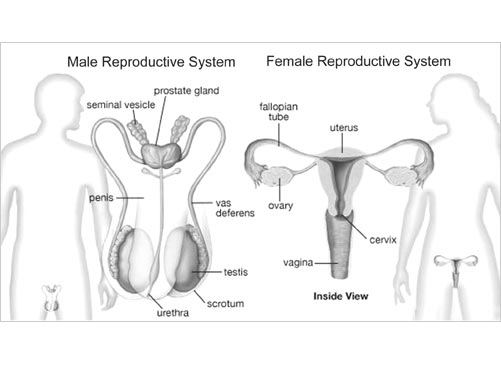Reproduction: The generating system

X Class - CCE Method
In plants and animals reproduction is necessary for continuation of life by the production of offspring (young ones).
You have learnt that offspring are produced from parents either by fusion of gametes or without it. The process of reproduction where fusion of gametes are not involved is asexual reproduction and where fusion of gametes take place is called sexual reproduction.
Let us study some modes of reproduction involving a single parent, without involving gametes. These are as we know asexual modes of reproduction.
Asexual mode of reproduction Fission
Single celled organisms, such as paramecium and bacteria, which reproduce by splitting in two or more offsprings. This usually occurs in a symmetrical manner. When they split into two it is binary fission, when more it is multiple fission. This is often the only mode of reproduction for these organisms.
Budding
A growth on the body that grows to forms nearly identical copy of parent and then separates from the parent and becomes independent. As for example in yeast.
Fragmentation
Some animals can grow from a separate piece of parent animal. This can be from any part of the body. This happens in only the simplest animals, such as some flatworms, moulds, lichens, spirogyra etc. grow in this manner. These animals may also reproduce sexually.
Parthenogenesis
Now a days we are able to develop seed less fruits like bananas, grapes etc .This is a process of reproduction there is a shift from sexual to asexual mode of reproduction. In nature also this process occurs which we have utilised in growing organisms of our choice which have more desirable characters In this process generally the egg develops with out meiosis and fertilization. So the offsprings are diploid.
Parthenogenesis may occur in species that also show sexual reproduction. In addition some animals known as rotifers in which all reproduction is Parthenogenetic. There are no males known in these species. In another type of Parthenogenesis meiosis does occur and the egg(monoploid) can develop whether fertilized or not. The monoploid offsprings develop into males. The diploid into females. Reproduction This strange kind of reproduction occur in bees, ants and wasps. Here one finds asexual and sexual reproduction on almost simultaneously.
Regeneration
Many fully differentiated organisms have the ability to give rise to new individual organisms from their body parts. That is, if the individual is somehow cut or broken up into many pieces, many or these pieces grow into separate individuals.
Vegetative propagation
Natural propagation
Leaves: As in bryophyllum where small plants grow at the edge of leaves.
Stems: Aerial weak stems like runners and stolons, when they touch the ground, give off adventitious roots. When the connection with the parent plant is broken, the portion with the newly struck roots develops into an independent plant. Some examples for propagation by stem are from stolons, bulbs, corms, tuber, etc.
Artificial propagation
Cutting: Some plants grow individually when a piece of the parent plant having bud is cut from the existing plant. The lower part of this cutting is buried in moist cell. After few days the cut parts having buds grow as an individual plant.
Layering: A branch of the plant with at least one node is pulled towards the ground and a part of it is covered with moist soil leaving the tip of the branch exposed above the ground. After some time, new roots develop from the part of the branch buried in the soil. The branch is then cut off from the parent plant, the part which has developed roots grows to become a new plant.
Grafting: Two plants are joined together in such a way that two stems join and grow as a single plant. One which is attached to soil is called stock and the cut stem of another plant without roots is called scion. Both stock and scion are tied with help of a twine thread and covered by a polythene cover. Grafting is used to obtain a plant with desirable characters.
Bit Bank : Reproduction: The generating system

1.Which of the following is not a unicellular organism ?(C)
A. Amoeba
B. Paramoecium
C. Hydra
D. Yeast
2.Which of the following shows budding ?(A)
A. Yeast
B. Amoeba
C. Paramoecium
D. Plasmodium
3.Which of the following shows multiple fission ?(D)
A. Hydra
B. Yeast
C. Spirogyra
D. Plasmodium
4.Which is the most common method of reproduction in majority of fungi and bacteria?(D)
A. Binary fission
B. Multiple fission
C. Budding
D. Spore formation
5.Which of the following shows spore formation ?(B)
A. Amoeba
B. Mucor
C. Plasmodium
D.Paramoecium
6.Regeneration is observed in _____.(B)
A. Amoeba
B. Planaria
C. Spirogyra
D. Yeast
7.Which of the following does not show regeneration ?(A)
A. Mucor
B. Planaria
C. Sponges
D. Starfish
8.Which of the following is not an artificial method of vegetative propagation ?(D)
A. Cutting
B. Layering
C. Grafting
D. Hybridization
9.Testes produce __ hormone.(B)
A. Estrogen
B. Testosterone
C. Progesterone
D. Both estrogen & testosterone
10.Which of the following is not produced in the ovary ?(D)
A. Ovum
B. Estrogen
C. Progesterone
D. Testosterone
11.The main reproductive organ of human male is ____.(A)
A. a pair of testes
B. vas deferens
C. urethra
D. penis
12.The main female reproductive organ is ______.(D)
A. Fallopian tubes
B. uterus
C. vagina
D. a pair of ovaries
-
Related News
-
More from Metro India

